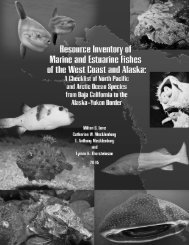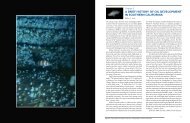Reproductive Ecology and Body Burden of Resident ... - The Love Lab
Reproductive Ecology and Body Burden of Resident ... - The Love Lab
Reproductive Ecology and Body Burden of Resident ... - The Love Lab
Create successful ePaper yourself
Turn your PDF publications into a flip-book with our unique Google optimized e-Paper software.
sider the ecology <strong>of</strong> species <strong>of</strong> interest that utilize the platform including the degree <strong>of</strong> connectivity between<br />
platform <strong>and</strong> natural habitat. Juvenile fish recruiting to a platform may utilize the platform for a period<br />
<strong>of</strong> time <strong>and</strong> emigrate to other habitat or remain at the platform throughout adult life. Adults may migrate<br />
between platforms <strong>and</strong> natural areas. A “platform fingerprint,” an otolith microchemical marker, ultimately<br />
can be used to estimate the degree to which adult fish or juvenile fish that have used platforms as nursery<br />
habitat migrate to local <strong>and</strong> perhaps regional populations in natural areas <strong>of</strong>f California. This goal <strong>of</strong> this<br />
study is to determine whether fishes, residing in the mid-water habitat or bottom habitat <strong>of</strong> platforms, possess<br />
unique otolith microchemical signatures—platform fingerprints.<br />
<strong>The</strong> specific objectives <strong>of</strong> this study were:<br />
1. To determine if otolith microchemistry can be used to distinguish fishes that reside at platforms<br />
from those that reside at natural habitat; <strong>and</strong><br />
2. To determine whether otolith chemistry is related to the water chemistry <strong>of</strong> the environment<br />
where fishes reside.<br />
Methods<br />
Fish <strong>and</strong> seawater sample collection<br />
Adult <strong>and</strong> subadult specimens <strong>of</strong> kelp rockfish (Sebastes atrovirens) <strong>and</strong> Pacific s<strong>and</strong>dab (Citharichthys<br />
sordidus) were sampled from six platforms <strong>and</strong> twelve natural areas (Table 1). Both species reside at the<br />
platforms <strong>and</strong> natural sites during all seasons <strong>and</strong> were sufficient in number to be selected for this study. We<br />
collected kelp rockfish on the platform structure at midwater depths <strong>and</strong> in kelp forests <strong>of</strong> rocky reef habitat.<br />
We collected the bottom-dwelling Pacific s<strong>and</strong>dab on s<strong>of</strong>t sediment within 100m <strong>of</strong> the platforms <strong>and</strong><br />
at natural sites at least 3 km away from the platform. Given that circulation patterns in the Santa Barbara<br />
Channel region are complex <strong>and</strong> different water masses with unique element composition are expected to<br />
be distributed within the study region at any one time, we (1) selected platforms located in several different<br />
water masses; (2) selected natural habitat sites that were outside <strong>of</strong> the sphere <strong>of</strong> influence <strong>of</strong> discharges<br />
from platform operations; <strong>and</strong> (3) paired each platform <strong>and</strong> natural site within the same water mass to<br />
partition variability due to the effect <strong>of</strong> natural water mass differences within pairs that might confound our<br />
test for a platform effect on otolith elemental signatures (Figure 1, Table 1). Platforms <strong>and</strong> natural habitat<br />
sites were located in six geographic areas that we designated: Point Conception (PTC), west Santa Barbara<br />
(WSB), east Santa Barbara (ESB), east entrance <strong>of</strong> the Santa Barbara Channel (EEC), <strong>of</strong>fshore east Channel<br />
(OEC), <strong>and</strong> Southern California Bight south <strong>of</strong> the Channel (SCB).<br />
Kelp rockfish were collected by spear using SCUBA at four platforms at midwater depths at six kelp<br />
forest habitat sites (Table 1). Pacific s<strong>and</strong>dab were collected by hook <strong>and</strong> line at six platforms <strong>and</strong> six natural<br />
habitat sites. At each collection site, fish were bagged together in a plastic bag <strong>and</strong> kept on ice for up to ten<br />
hours. <strong>The</strong> fish were either processed in the laboratory on the collection day or the whole body samples<br />
were frozen until they were thawed <strong>and</strong> processed several weeks later. We measured fish total length (TL)<br />
<strong>and</strong> st<strong>and</strong>ard length (SL) to the nearest millimeter (mm), <strong>and</strong> weighed fish to the nearest gram (g). Sagittal<br />
otoliths were extracted from 8-10 fish specimens per site, rinsed in DI water, <strong>and</strong> stored dry in a clean plastic<br />
snap cap vial until the time <strong>of</strong> preparation for otolith microchemistry. <strong>The</strong> otoliths were measured along the<br />
axis <strong>of</strong> the sulcus to the nearest 0.05 mm <strong>and</strong> weighed to the nearest 0.001 mg.<br />
We collected seawater samples at the study sites to examine the relationship between otolith chemistry<br />
<strong>and</strong> seawater chemistry. Seawater samples were collected at the time <strong>of</strong> sampling fish for the otolith microchemistry<br />
analysis. Three seawater samples were collected near the depth fish were sampled from separate<br />
35




